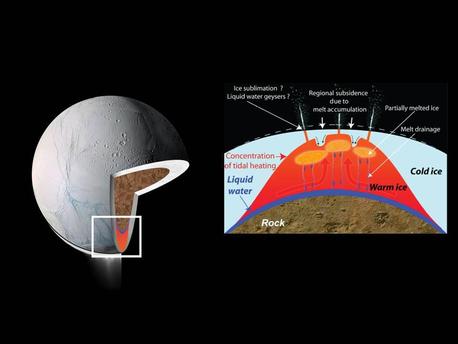New Data From Cassini
Big Burb: Enceladus in Motion
 © NASA/JPL
|
These drawings depict explanations for the source of intense heat that has been measured coming from Enceladus' south polar region. These models predict that water could exist in a deep layer as an ocean or sea and also near the surface. Cassini scientists infer that the temperature of the ice in the south polar region must be close to its melting point (shown in red). A layer of liquid water (dark blue) might exist between the ice and the silicate core (brown), allowing the ice to deform independent of the rock, providing even more mechanical energy and more flexing of the icy shell for extreme tidal heating.
The south polar region captivates scientists because it hosts the fissures known as "tiger stripes" that spray water vapor and other particles out from the moon. While the latest paper, released on Jan. 10, doesn't link the churning and resurfacing directly to the formation of fissures and jets, it does fill in some of the blanks in the region's history.
"This episodic model helps to solve one of the most perplexing mysteries of Enceladus," said Bob Pappalardo of the research done by his colleagues. "Why is the south polar surface so young? How could this amount of heat be pumped out at the moon's south pole? This idea assembles the pieces of the puzzle."
About four years ago, Cassini's composite infrared spectrometer instrument detected a heat flow in the south polar region of at least 6 gigawatts, the equivalent of at least a dozen electric power plants. This is at least three times as much heat as an average region of Earth of similar area would produce, despite Enceladus' small size. The region was also later found by Cassini's ion and neutral mass spectrometer instrument to be swiftly expelling argon, which comes from rocks decaying radioactively and has a well-known rate of decay.
Calculations told scientists it would be impossible for Enceladus to have continually produced heat and gas at this rate. Tidal movement – the pull and push from Saturn as Enceladus moves around the planet – cannot explain the release of so much energy.
The surface ages of different regions of Enceladus also show great diversity. Heavily cratered plains in the northern part of the moon appear to be as old as 4.2 billion years, while a region near the equator known as Sarandib Planitia is between 170 million and 3.7 billion years old. The south polar area, however, appears to be less than 100 million years old, possibly as young as 500,000 years.
A new model showed that heat building up from the interior of Enceladus could be released in episodic bubbles of warm, light ice rising to the surface, akin to the rising blobs of heated wax in a lava lamp. The rise of the warm bubbles would send cold, heavier ice down into the interior. (Warm is, of course, relative. Nimmo said the bubbles are probably just below freezing, which is 273 degrees Kelvin or 32 degrees Farenheit, whereas the surface is a frigid 80 degrees Kelvin or -316 degrees Fahrenheit.)
The model fits the activity on Enceladus when the churning and resurfacing periods are assumed to last about 10 million years, and the quiet periods, when the surface ice is undisturbed, last about 100 million to two billion years. Their model suggests the active periods have occurred only 1 to 10 percent of the time that Enceladus has existed and have recycled 10 to 40 percent of the surface. The active area around Enceladus's south pole is about 10 percent of its surface.
Redshift live created a workspace showing Enceladus and Saturn. Open it with Redshift 7 and explore that region of space yourself. If you do not have Redshift - no problem you can download the free Launcher here.
Source: NASA
New Data From Cassini
Big Burb: Enceladus in Motion
 © NASA/JPL
|
These drawings depict explanations for the source of intense heat that has been measured coming from Enceladus' south polar region. These models predict that water could exist in a deep layer as an ocean or sea and also near the surface. Cassini scientists infer that the temperature of the ice in the south polar region must be close to its melting point (shown in red). A layer of liquid water (dark blue) might exist between the ice and the silicate core (brown), allowing the ice to deform independent of the rock, providing even more mechanical energy and more flexing of the icy shell for extreme tidal heating.
The south polar region captivates scientists because it hosts the fissures known as "tiger stripes" that spray water vapor and other particles out from the moon. While the latest paper, released on Jan. 10, doesn't link the churning and resurfacing directly to the formation of fissures and jets, it does fill in some of the blanks in the region's history.
"This episodic model helps to solve one of the most perplexing mysteries of Enceladus," said Bob Pappalardo of the research done by his colleagues. "Why is the south polar surface so young? How could this amount of heat be pumped out at the moon's south pole? This idea assembles the pieces of the puzzle."
About four years ago, Cassini's composite infrared spectrometer instrument detected a heat flow in the south polar region of at least 6 gigawatts, the equivalent of at least a dozen electric power plants. This is at least three times as much heat as an average region of Earth of similar area would produce, despite Enceladus' small size. The region was also later found by Cassini's ion and neutral mass spectrometer instrument to be swiftly expelling argon, which comes from rocks decaying radioactively and has a well-known rate of decay.
Calculations told scientists it would be impossible for Enceladus to have continually produced heat and gas at this rate. Tidal movement – the pull and push from Saturn as Enceladus moves around the planet – cannot explain the release of so much energy.
The surface ages of different regions of Enceladus also show great diversity. Heavily cratered plains in the northern part of the moon appear to be as old as 4.2 billion years, while a region near the equator known as Sarandib Planitia is between 170 million and 3.7 billion years old. The south polar area, however, appears to be less than 100 million years old, possibly as young as 500,000 years.
A new model showed that heat building up from the interior of Enceladus could be released in episodic bubbles of warm, light ice rising to the surface, akin to the rising blobs of heated wax in a lava lamp. The rise of the warm bubbles would send cold, heavier ice down into the interior. (Warm is, of course, relative. Nimmo said the bubbles are probably just below freezing, which is 273 degrees Kelvin or 32 degrees Farenheit, whereas the surface is a frigid 80 degrees Kelvin or -316 degrees Fahrenheit.)
The model fits the activity on Enceladus when the churning and resurfacing periods are assumed to last about 10 million years, and the quiet periods, when the surface ice is undisturbed, last about 100 million to two billion years. Their model suggests the active periods have occurred only 1 to 10 percent of the time that Enceladus has existed and have recycled 10 to 40 percent of the surface. The active area around Enceladus's south pole is about 10 percent of its surface.
Redshift live created a workspace showing Enceladus and Saturn. Open it with Redshift 7 and explore that region of space yourself. If you do not have Redshift - no problem you can download the free Launcher here.
Source: NASA






